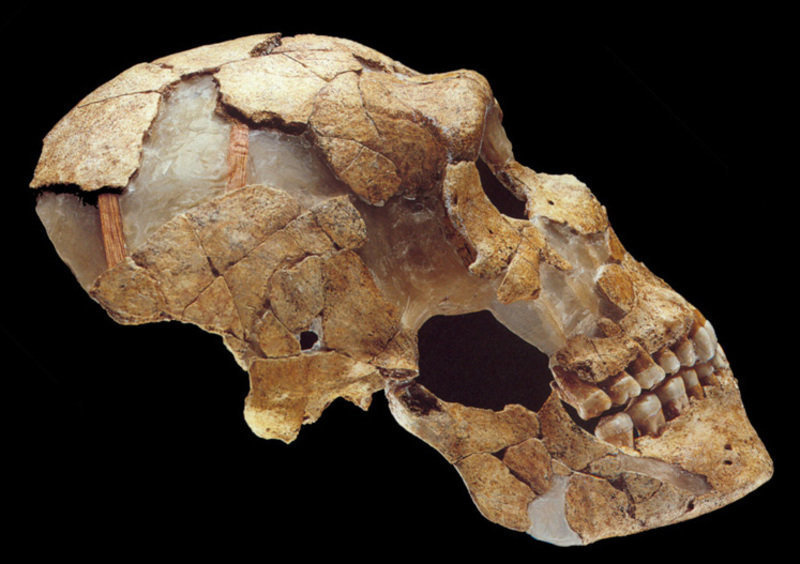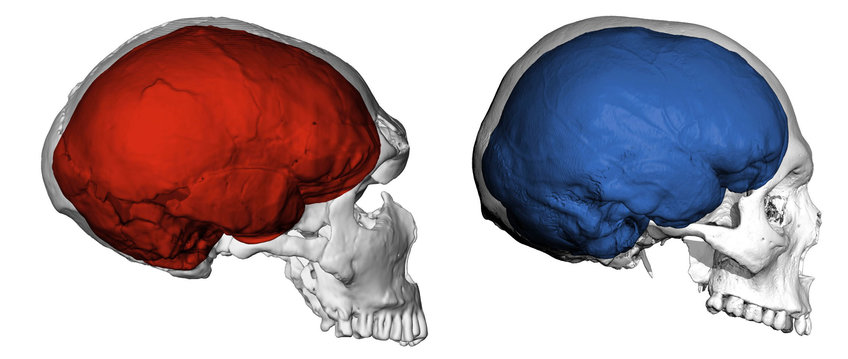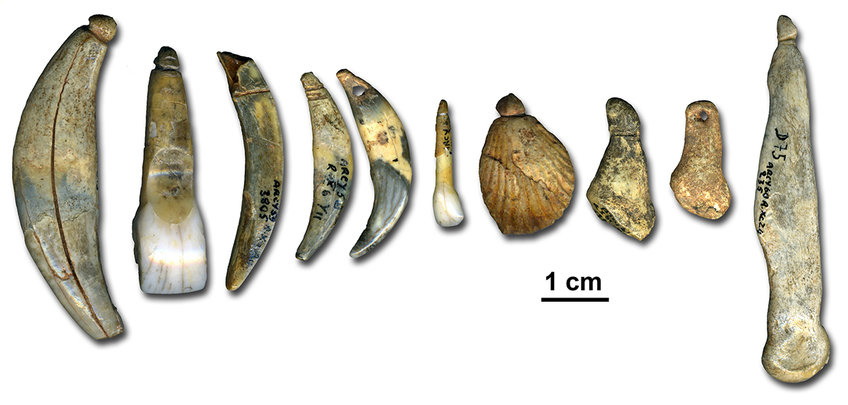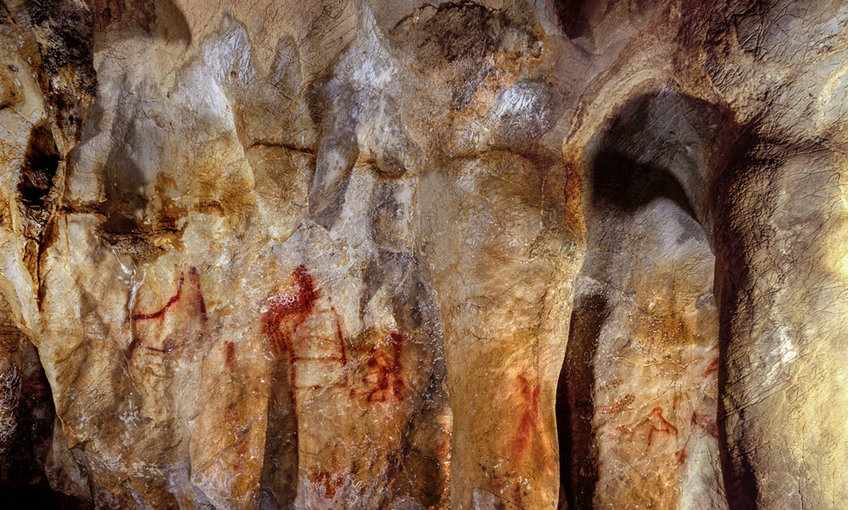
The Neandertals
Neandertals are an extinct group of humans and the closest evolutionary relatives of humans living today. The oldest known Neandertals are about 400,000 years old and they became extinct about 40,000 years ago. They lived in Europe, the Middle East, Central Asia and western Siberia.
Their name comes from the site where workers in a limestone quarry discovered parts of a skull and bones in 1856: the Neandertal near Düsseldorf. Although the skull was as large as that of a human being living today, it also showed clear differences: Compared to present day humans, the Neandertals had more pronounced eyebrow bulges and a fleeing forehead. Neandertals also had a chinless face with peculiar nasal cavities, which made it easier to warm up cold air when inhaling.
How did Neandertals look like?

Their bones were stronger, their pelvis wider and their limbs shorter. At a maximum of 1.70 metres, Neandertals were not particularly tall, but of sturdy stature and strong, with a wide and deep chest - all adaptations to the cold climate of the Ice Age, which caused the Neandertals' bodies to lose less warmth. The men weighed up to 90 kilos. Genetic analyses indicate that Neandertals, like humans today, had different hair colours and skin tones. All in all, Neandertals could mostly be distinguished externally from people living today by their unusual face.
Since brains do not petrify, the brain structure of early humans cannot be examined directly. Indirect clues do, however, exist: the shape of the skull. The internal volume of the brain skull shows that Neandertals and modern humans had brains of similar size. Structures on the inside of the cranium reveal the shape of the basal brain and different lobes.

At the Max Planck Institute for Evolutionary Anthropology in Leipzig, Jean-Jacques Hublin and his colleagues have taken three-dimensional X-rays of fossil skulls and created virtual impressions of the brain skull using modern computer tomography. This revealed that the temporal lobes of the cerebral cortex, which are involved in speech and memory, and the olfactory lobes of Homo sapiens are larger than those of Neandertals. This could indicate a better or differently functioning sense of smell in present day humans.
Neandertals may have lived at a faster pace, they seem to have grown up faster than Homo sapiens. For example, the enamel analysis of a Neandertal child showed that their full dentition was completed one to two years earlier than the offspring of modern humans. The prolonged maturation period facilitates learning and possibly gave Homo sapiens a decisive advantage over his cousin.
There were also differences in the development of the brain. At birth, Neandertals and Homo sapiens still have brains of about the same size and elongated skulls. While in modern humans the typical round skull form develops in the first year of life, this phase of brain development is missing in Neandertals.
These differences have probably had an effect on the neuronal structure of the brain and thus on the mental, emotional and communicative abilities of Neandertals. Some scientists therefore suspect that it is unlikely that Neandertals have perceived the world the way we do.
Did Neandertals have language?
Nevertheless, scientists assume that Neandertals were also able to speak. At least the anatomical prerequisites for this seem to be given: The analysis of an inconspicuous bone of a 60,000-year-old Neandertal showed that the hyoid bone of the Neandertal was shaped in a similar way to the hyoid bone of today's humans. Many tendons and ligaments attach to the hyoid bone, providing the necessary mobility of the tongue for speech. Many researchers conclude from this that the Neandertals were able to speak - whether in a primitive spoken language or a complex language like ours, however, cannot be said in this way.
Neandertals, however, must have been able to pass on complex knowledge to their peers. This is indicated by many of their abilities, such as the production of sophisticated tools, the use of fire or group hunting of big game. Moreover, according to recent research, they seem to have mastered abstract thinking and used symbols such as paintings and body jewellery to communicate. There is even evidence that some of them buried their dead in graves. Genetic analyses carried out by scientists at the Max Planck Institute for Evolutionary Anthropology in Leipzig have also shown that some features of the protein encoded by the FOXP2 gene, which are important for language, are found also in Neandertals.
Scientists have reconstructed the origin of Neandertals on the basis of further bone finds in the 20th century: A lower jaw discovered as early as 1907 near Heidelberg is one of the oldest evidence of the presence of members of the genus Homo - so-called hominids - in Europe with an age of around 600,000 years. Jaws and teeth are anatomically a mixture between the African Homo erectus and the Neandertal. Homo heidelbergensis, sometimes classified as a species of its own, could therefore mark the transition between these two early humans.
When did Neandertals and modern humans emerge?
A pioneer of paleogenetics
Although hundreds of Neandertal remains have been discovered, complete skeletons remain rather rare and most of them where found in the first half of the 20th century, when excavation techniques were rather rough. Accordingly, more than 150 years after the discovery of the Neandertals, our knowledge about the lives of these people would still be even more incomplete if it had not been for the fact that some time ago new fields of research had made possible findings that were not thought possible: palaeogenetics and palaeoproteomics.
A pioneer in the field of palaeogenetics is Svante Pääbo. Together with his team at the Max Planck Institute for Evolutionary Anthropology in Leipzig, the scientist has developed new methods with which he can identify and analyse the genetic material that is sometimes still contained in bones that are thousands of years old. DNA comparisons between Neandertals, modern humans and other early modern humans have helped clarify the origin and ancestry of the different human forms.
The DNA analyses carried out by Pääbo and his colleagues suggest that the lines of Neandertal and Homo sapiens separated about 600,000 years ago. In Africa, Homo sapiens eventually emerged about 300,000 years ago. Neandertals evolved in Europe and the Denisovans in Asia. The Neandertals are therefore not the ancestors of today’s humans, they rather evolved parallel to them.
Did Neandertals and modern humans mix?

Until a few years ago, researchers assumed that this evolution took place independently of each other. Indeed, when Svante Pääbo's team first published the Neandertal mitochondrial genome, nothing seemed to indicate an exchange of genes. However, when Pääbo finally succeeded in deciphering the nuclear Neandertal genome, it became clear that Neandertals passed on large parts of their genome to modern humans. As a consequence, one to three percent of the genomes of people living outside Africa today stems from Neandertals.
In addition, the so-called Denisovans – an Asian relative of Neandertals dicovered in 2010 by Johannes Krause and others in in Pääbo's team – passed on genes to the ancestors present-day Asians. Consequently, about five percent the genomes of people living Papua New Guinea comes from Denisovans.
Recently, Pääbo‘s team has found more evidence that different human forms mixed with each other. For example, when they investigated the DNA of the lower jaw of a modern human who lived about 40,000 years ago in Romania, they found that the proportion of Neandertal DNA in this individual was so large that he must have had a Neandertal ancestor between four and six generations back in his family tree. Even more strikingly, in 2018 Viviane Slon in the Leipzig team extracted DNA from a bone splinter from the Denisova Cave and found that it came from a female with a Neandertal mother and a Denisovan father. This may suggest that Neandertals and Denisovans produced children together relatively frequently when they encountered each other.
Which genes did we inherit from Neandertals?
Modern humans seem to have benefited from Neandertal genetic variants. For example, researchers have discovered Neandertal DNA segments that occur in modern humans and are responsible for the degradation of fats. Today, other Neandertal genes strengthen our immune system. For example, variants of so-called toll-like receptors that are important for how the immune system is able to fight off infections have been contributed by both Neandertals and Denisovans to modern humans and seem to have been of value as they have increased in frequency in Europe and Asia.
The brain development of modern humans has also been influenced by gene variants of Neandertals. They have an effect on the shape of the skull and above all on brain areas for the planning and coordination of movements. The researchers found the strongest evidence for the effects of this Neandertal DNA on gene activity in putamen, a basal ganglia, and in the cerebellum.
Our Neandertal heritage also affects properties such as skin tone, hair color, sleep, mood, and even whether a person smokes. For example, people with certain Neandertal variants smoke more frequently on average. So-called "night people" often also possess certain Neandertal DNA. Scientists have compared Neandertal gene variants in our genome with genetic information from a British database, which also contains personal data on appearance, nutrition, behaviour and diseases.
How did Neandertals live?

As hunters and gatherers, Neandertals were very mobile and probably roamed many thousands of square kilometres of land. They lived in small groups of no more than 50 to 60 women and men. As the genetic analyses show, even Neandertals living several thousand kilometres apart were relatively closely related. Researchers conclude that early humans were rare most of the time. Even at a time when they were most widespread, there were probably no more than 10,000 Neandertals throughout Europe.
Neandertals have fed primarily on meat, as the analysis of amino acids in teeth and bones has shown. They were excellent hunters, killing even big game such as mammoths, bison and horses. But also vegetable food was certainly on their diet. Neandertals were also technically adept. For more than 200,000 years there remains are associated with so-called Mousterian stone tools. The Mousterian sites contain tools such as side-scrapers, points and various types of flakes that were typically cut off from flint.

44,000 to 40,000 years ago, the Neandertals finally developed the culture of the Châtelperronien. Until then, it was unclear whether Homo sapiens or Neandertals had created the tools and jewellery of this period. It was only through the combination of palaeoproteomics and palaeogenetics that Jean-Jacques Hublin and Svante Pääbo of the Max Planck Institute in Leipzig were able to prove that Neandertals had produced objects that had previously been attributed to modern humans.
It is now known that they also created symbolic objects and paintings. Around 180,000 years ago, Neandertals created a circle of broken stalactites in a cave in southwestern France, venturing over 300 metres deep into the cave. The function of this so far oldest known building of early humans is unknown.
Burial sites, on the other hand, indicate that they have dealt with death - all abilities that until then only Homo sapiens had conceded to researchers. Since the oldest cave paintings, figures, decorated bone tools and jewellery known in Europe to date date from the time of the so-called "Late Palaeolithic Revolution" some 40,000 years ago and Homo sapiens immigrated to Europe during this period, many scientists assumed that these objects had been created by modern humans.
Did Neandertals produce art?

Thanks to a new dating method, researchers can now determine the age of lime crusts on paintings and objects. An international research team led by Dirk Hoffmann of the Max Planck Institute for Evolutionary Anthropology in Leipzig has used this uranium-thorium dating to investigate art from caves in Spain. According to the researchers, the paintings, are more than 64,000 years old and thus at least 20,000 years older than the earliest traces of modern man in Europe. They consist of simple geometric signs and handprints but do not yet include representations of animals. Naturally pierced shells, red and yellow pigments and containers with complex pigment mixtures from a cave in southeastern Spain were even dated by the researchers to be about 115,000 years old.
Did Homo sapiens inspire neandertals?
The scientists conclude from this that not only Homo sapiens, but also the Neandertal could think abstractly and that his mental abilities might have been close to our own. Other researchers suspect, however, that Neandertals did not produce sophisticated tools and body jewellery until Homo sapiens arrived in Europe. They would not have produced sophisticated tools and body jewellery on their own initiative, but would have been inspired to do so only after contact with modern people.
Why the Neandertals finally died around 40,000 years ago may never be certain. Likely the arrival of modern man in the mid-latitudes of Eurasia 45,000 years ago played an important role. Climate instability of that time period might also have accelerated the process.









